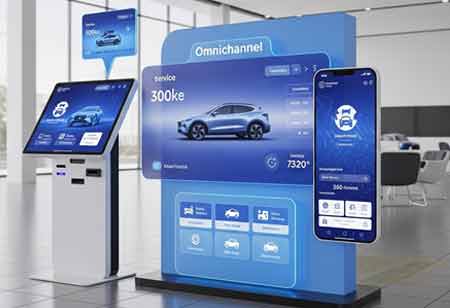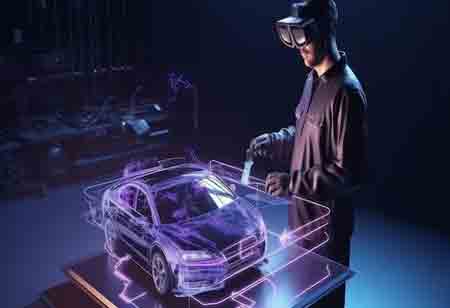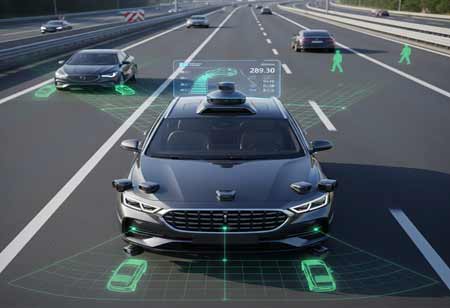THANK YOU FOR SUBSCRIBING
THANK YOU FOR SUBSCRIBING
Be first to read the latest tech news, Industry Leader's Insights, and CIO interviews of medium and large enterprises exclusively from Auto Tech Outlook

By
Auto Tech Outlook | Friday, September 19, 2025
Stay ahead of the industry with exclusive feature stories on the top companies, expert insights and the latest news delivered straight to your inbox. Subscribe today.
With clear, well-structured channels, the automotive industry has simply showered itself with showrooms, service centers, and all online or offline marketing platforms. However, the substance of waiting or being side-by-side with the thought structuring of what consumers usually do to research, engage, and make a purchase is changing.
Customers want to seamlessly interact with one another, all the way through their journey experience- an already trite statement that would probably be huffed and puffed away. This is because business people are launching omnichannel automotive platforms, which become integrated ecosystems offering sales, service, financing, and customer support at different touchpoints.
This is by treating the omnichannel as all about continuity and flexibility. Whether customers configure their vehicle online and take a test drive at a dealer, that transition between platforms must be smooth and informed by data. A well-organized omnichannel system enables the customer to feel a flow across departments and places, thus providing a sense of coherence and control.
Besides comfort, this facilitates trust because "the customers receive a personalized and highly responsive experience along the entire process." The concept reflects a much bigger trend within personalization, wherein technology is being used by businesses to deliver services aligned to an individual's needs and preferences.
Bridges Between Digital Touch Points and Face-to-Face Touch Points
At its best, an omnichannel automotive platform bridges public and online engagement with physical experience. Often, consumers start this process online, searching models, specs, and financing offers. Leaving the research phase of online activity and stepping into a physical experience—like going into a dealership—is the hallmark of modern customer satisfaction. When online actions are tied to in-store systems, sales personnel can reference past interactions, know the customer's vetting process, and offer better help.
This connected network makes for a clearer conversation and less time to repeat steps. For example, a customer can configure an individual vehicle online so that the dealership can pull up that information when they arrive, which can help speed the sales process along and show attentiveness to that customer's interest. In addition, most integrated platforms will feature options to schedule test drives, kick off trade-in appraisals, or complete paperwork remotely, without losing the quality of service. Since many customer journeys are now much more varied, providing a consistent experience across all touchpoints is quickly becoming the expected norm, not a value-added feature.
Better Use of Data for Effective Sales and Service
Omnichannel platforms are decisive in changing data usage in the automotive retail environment. The real-time connectivity of data enabled by unified systems brings in digital inquiries, service records, purchase histories, and customer feedback to form a holistic view of each customer. Such visibility can effectively forecast, plan inventories, and focus marketing initiatives. It can also systematically identify opportunities for cross-selling or follow-up at breaching points like the expiration of a lease or a service milestone in the customer life cycle.
The service department provides a combined data profile for technicians and advisors to better prepare for appointments. Omnivorous updates and digital communication, such as mobile alerts or online tracking of services, are then greatly enjoyed by customers. It is all about making customer experiences more transparent and giving them the belief that they are kept informed.
Long-term trust can also be created with predictive analytics based on service-related data, which promotes proactive maintenance reminders and thus minimizes costly repairs. Most importantly, they help dealers and service providers run at higher efficiency, along with improved customer satisfaction metrics.
Consistency in Brand Experience across All Channels
Adopting this omnichannel automotive platform enhances brand consistency across different platforms. Whether a customer interacts through a mobile app, dials to access a service line, dashes to the dealership, or browses online, the tone, content, and quality of information should mirror the brand's identity.
An integrated system harmonizes messaging, pricing, and product availability, clearing confusion and strengthening company positioning in the market. This increases brand loyalty and diminishes operational inconsistencies that will most likely negatively affect the customer experience.
Moreover, centralized platforms prepare staff to provide better training and internal communication. Employees from sales, service, and support divisions who are on the same page regarding tools and information will offer more consistent services and effectively collaborate. This internal alignment creates a unified external experience. Customers will encounter fewer discrepancies or mixed messages, adding to a consumer's overall journey from research to ownership. This ability becomes increasingly critical in a highly competitive market, as the omnichannel integrated experience becomes a direct differentiator for retention and referral.
 Copyright © 2025 AutoTech Outlook. All Rights Reserved | Privacy Policy | Subscribe | Sitemap | About us | Feedback Policy | Editorial Policy
Copyright © 2025 AutoTech Outlook. All Rights Reserved | Privacy Policy | Subscribe | Sitemap | About us | Feedback Policy | Editorial Policy 



